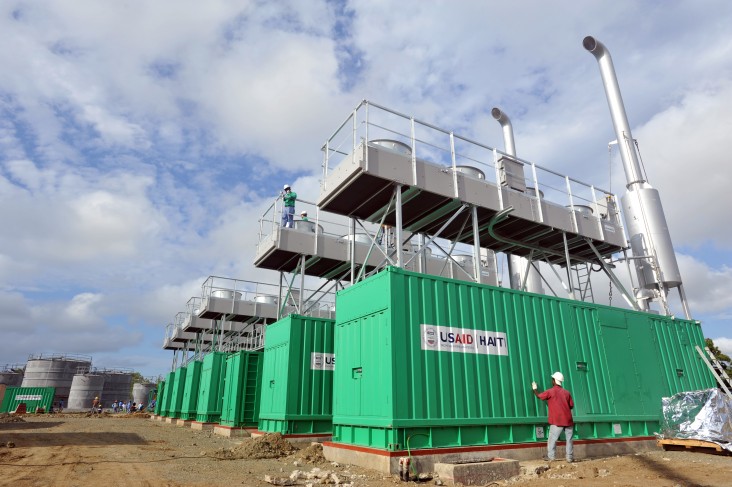
Overview
HAITI Energy Fact Sheet ![]() (pdf - 355k)
(pdf - 355k)
Haiti is facing two energy challenges: a broken electricity sector and dependency on charcoal. The electricity sector in Haiti is among the most challenged in the region. Only about one-quarter of the population had access to electricity prior to the 2010 earthquake, and that remains the case today. Of these consumers, half were connected to the electrical grid illegally. In place of a national grid, the national power utility, Electricité d’Haïti (EDH), operates one primary grid serving the Port-au-Prince metropolitan area and a small number of isolated power grids for the rest of the country. Existing distribution systems are weak and require rehabilitation.
Even for those with access to electricity, reliability is inconsistent. This lack of reliability requires many businesses and households to install costly, inefficient, and environmentally unfriendly diesel generators. Although residential tariffs in Haiti are relatively low compared with other fossil-fuel-dependent countries in the region, commercial and industrial tariffs are amongst the highest. This lack of access to affordable and reliable power hinders investment, constrains the development of productive businesses, and degrades living standards for residential customers.
The fuel of choice for food preparation for the bulk of households in Haiti is wood, including charcoal. The annual consumption of wood products by Haitians is estimated at 4 million metric tons (MT), of which about one-third is transformed into charcoal to meet the cooking fuel needs of urban consumers. Apart from the negative environmental impact of cutting trees for fuel, cooking with firewood and charcoal exposes the populace, especially women and young children, to smoke and indoor air pollution.
Key Challenges
Billings and Collection: Electricity tariff collections in communes where residents have historically connected illegally to the EDH grid continue to be very low. As such, the national utility is not able to cover all costs associated with generation, transmission, and distribution – much less make investments that are necessary for improving and expanding the provision of electricity service.
Dependency on Charcoal: Rural populations have less access to cleaner fuels and continue to depend on traditional three-stone open fires and/or inefficient biomass (charcoal or wood) cookstoves. In addition to significant financial and infrastructure barriers to adopting cleaner cooking technologies, another barrier deals with changing attitudes toward how people traditionally approach food preparation, especially at the household level.
USAID Strategy & Activities
The U.S. Agency for International Development (USAID) is demonstrating that a sustainable electric utility can operate in Haiti. A pilot program is in place in the north with a power plant providing continuous, reliable electricity to the tenants of the Caracol Industrial Park as well as residences and businesses in five surrounding communities. The objective of USAID’s program is to establish a financially viable electric utility that provides dependable, affordable electricity to customers while implementing a payment structure that results in a high collection rate of electricity bills. One key goal is to create an environment that will attract private sector interest in taking over the utility’s operations and maintenance responsibilities, resulting in the long-term sustainability of the electric utility. Two main activities to support this program include:
Building a Pilot Project for the Sustainable Electricity Distribution (PPSELD): USAID funded the construction of a 10 megawatt (MW) power plant with transmission and distribution facilities to serve the Caracol Industrial Park tenants as well as commercial and residential customers in the surrounding villages. The 10MW power plant provides uninterrupted 24/7 electricity to 8,000-metered customers.
Improving Utility Services to Facilitate Collection of Electricity Bills: The utility in the north has made in-roads in reducing electricity theft, properly installing connections and improving collection of electricity bills for customers with working meters. For those customers with regularized electricity service (proper connections and meters), the collection rates for electricity bills is above 90 percent, compared to below 25 percent for those customers in other parts of the country with electricity provided by the national electric utility.
Related Links
- First Microgrid in Haiti: The Road to Feminist Electrification
- Changing Lives With Solar Microgrids
- Wanted: Clean, Smart, Affordable Energy for Haitian Community
- Electricity Sparks Life into Northern Haiti
- Cooking With Green Charcoal Helps to Reduce Deforestation in Haiti
- Cleaner Cooking in Haiti's Schools
- Cooks Switch From Charcoal to Gas for Better Health in Haiti








Comment
Make a general inquiry or suggest an improvement.